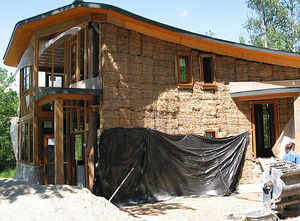Papercrete vs. StrawBale

We have researched and compared papercrete and straw bale as alternatives to the most common types of building material based on criteria such as r-value, cost of production and pollution concerns. The purpose is to see how appropriate these materials are for application depending on location and personal choice.
Background[edit | edit source]
Even though we might be accustomed to only a few different types of building materials in the United States, there are many alternatives to the typical wood and sheet rock or redbrick buildings. Some alternatives are more "environmentally friendly" than others and better suited to certain locations but by what factors can these decisions be made? How can they be compared? We had the opportunity to research papercrete and straw bale building materials as alternatives to the typical and most common building materials and develop a materials evaluator spreadsheet to compare the two.
Straw bale houses were very popular among settlers in the plains areas for the abundance of straw and the insulative properties useful during long cold winters. Once the mass production of construction materials in the 1950's started, straw bale construction began to lose popularity. Straw bale could not compete with the cheapness and quickness of application of mass produced materials, but due to the appropriate technologies movement in the 1970's there was a resurgence of people interested in the application of straw bale as a building material. It is a byproduct of grain harvesting and usually becomes waste. It has an amazing r-value which reduces the need for heating in the winter and air conditioning in the summer and can withstand strong seismic activity because of its compressive strength and flexibility.
Papercrete is a building material made from cement, shredded paper and sand. Waste paper can be used-and should be used-and the ratios of the component materials can be adjusted to meet the needs of the builder. The application of papercrete is versatile because it can be shaped into many different forms. Different size bricks can be formed to meet the specifications of particular projects and they can be made and stored on site over a period of time.
Problem statement[edit | edit source]
The Campus Center for Appropriate Technologies (CCAT) at Cal Poly Humboldt has asked us, as students of Engineering, to research different building materials for a tool shed that they will be building on site. The shed will not only be functional but will be a teaching tool and demonstration piece for the community.
Our goal in researching these two materials is to determine which one is more suitable for our location based on a number of different comparable criteria such as transportation costs, CO2 emissions, and R-Value. Just because there is an alternative building material doesn't necessarily make it the best choice. If one material takes more fuel, creates more pollution and uses up more natural resources than another it might be wise to take another look before any decision is made.
Instructions[edit | edit source]
Our materials evaluator spreadsheet, Media:Straw bale vs papercrete.xls, is dynamic and user friendly. This spreadsheet allows the user to change values in the red cells to determine which material is best suited for their project. On sheet two of the spreadsheet is the calculations page for the "winner". On this sheet the red cells contain weights on a scale of 1-10. These weights reflect how important each characteristic is to the user and may be adjusted. For example, cost may be extremely important to one user and assigned a weight of "10", while another user may not be as concerned with cost and may assign it a weight of "5". After all of the input has been adjusted in the red cells and the user hits enter, the new "winner" will appear in the "winner" box. There is a ruby red scale bar in the "winner" box that displays by how much the "winner" won. In addition, if the "winner" is straw bale the "winner" box will turn yellow. If the "winner" is papercrete the "winner" box will turn gray.

Justifications[edit | edit source]
Average straw yields for the 2003-2004 growing season were found at the University of Kentucky Spindletop Farm, Lexington, KY. This provided us the information on what the average price per bale should be-[1] Farming information including average fuel useage per acre. From this site we gathered part of the equation needed in figuring out carbon emissions-[2] Strawbale weight and dimensions, this allowed us to calculate how many bales needed per shed-[3] John Deere 8030 Series Tractors: Record-setting fuel efficiency!(15.13Hp*hr/gal. Data we used in determining carbon emissions-[4] The most comprehensive straw bale site we've found (Great References)- Canada based site that addresses history, method, load bearing capacity, applications, and common concerns (i.e. height limitations, rot, fire, longevity...). These became most of the characteristics used to compare straw bale to papercrete -[5] We found the prices of straw bale from a local distributor in our town. This source also helped us factor in the distance that the straw travels from the harvesting site to the construction site. There was also a project in central California that got their straw from the same area. This transport distance provided more information to calculate carbon emissions-,[6][7] Papercrete can be made using various ratios of materials. We tried to match our information with the some of the most common forms and mixtures used for load bearing construction. This standardization allowed us to make compare it to strawbale- we found a lot of information through living paper.com that provided how to's, mixes and instructions.[8] We also found a lot of information concerning statistics on the CO2 emissions of cement as well as graphs for analysis on papercrete. We used this information to compare cement CO2 emissions with straw bale CO2 emissions.-[9]
Results[edit | edit source]
We were able to determine which material is most appropriate for the CCAT shed project by entering collected data and stated assumptions in our dynamic materials evaluator spreadsheet. Initially we had thought that straw bale would be our material of choice because it consists almost entirely of natural and recycled material and the production the cement used in papercrete is energy intensive. But once we put the weights to what we valued most and considered why we were building the shed our results showed that papercrete is more appropriate. The results of each characteristic evaluation can be viewed on the Media:Straw bale vs papercrete.xls spreadsheet.
Conclusions[edit | edit source]
Even though straw bale is much less energy intensive in extraction than the cement used in papercrete, we chose papercrete as our building material based on our spreadsheet analysis. We valued and weighted the various categories and papercrete came out as the "winner" in our materials evaluator spreadsheet. Detailed results can be viewed on the Media:Straw bale vs papercrete.xls spreadsheet.
Discussion and next steps[edit | edit source]
This project and analysis could be improved and expanded upon in many ways. We only researched and analyzed two materials, straw bale and papercrete, and more materials can be evaluated based on our selected characteristics. One way in which we would like to improve this project is by adding common, conventional building materials used in stick frame, timber frame, and concrete block construction to display how alternative building materials compare. We believe that it is important to add these materials to our comparison since the purpose of determining which materials are most "appropriate" is to reduce consumption and pollution resulting from the use of conventional building materials.
Credits[edit | edit source]
Sean Gavlas, Jessica Fowler, Brandon Barlow, Graham Felsenthal Cal Poly Humboldt - Arcata, CA
December 2008
References[edit | edit source]
- ↑ http://web.archive.org/web/20080807171754/http://www.uky.edu/Ag/GrainCrops/Research/Research_pdf/SmallGrains_StrawYields2005.pdf
- ↑ http://web.archive.org/web/20100107110945/http://www.precisiontillage.com:80/assets/uploads/Costs%20and%20Fuel%20Use.pdf
- ↑ http://www.buildinggreen.com/auth/image.cfm?imageName=images/0403/baledimensions.jpg&fileName=040301a.xml
- ↑ http://web.archive.org/web/20090928023435/http://www.deere.com:80/en_US/ag/feature/2008/8030_fuel_efficiency.html
- ↑ - http://web.archive.org/web/20120301034803/http://harvesthomes.ca/building/straw_bale_primer.pdf
- ↑ 3G's Hay and Grain, Arcata California
- ↑ http://web.archive.org/web/20150416032546/http://www.presentationcenter.org:80/Environment/Welcome_Center/WC_Construction/straw_bale.html
- ↑ http://www.livinginpaper.com
- ↑ http://www.buildingforafuture.co.uk/autumn05/ordinary_portland_cement.pdf

